Understanding the anatomy of your bike is crucial for maintenance, repairs, and even just communicating effectively about cycling. Whether you’re a seasoned cyclist or just starting out, knowing the names and functions of each part will enhance your riding experience. This guide breaks down the essential components of a bicycle, from the frame to the smallest fittings, in an easy-to-understand format.
Bike Frame Parts
The bike frame is the foundational structure, the rigid skeleton upon which all other components are mounted. Historically, steel was the material of choice for bike frames, prized for its strength and repairability. However, modern bikes often utilize aluminum alloy, offering a lighter weight alternative. High-performance bicycles may feature carbon fiber for its exceptional stiffness-to-weight ratio and vibration damping, or titanium for its durability and ride quality. A good frame balances strength, lightness, and stiffness for optimal performance and handling.
A “frameset” typically includes the frame and the fork, representing the core structural elements of the bicycle.
The most prevalent frame design is the “diamond frame,” characterized by its geometric efficiency and composed of six main tubes forming two interconnected triangles. This design provides excellent strength and rigidity.
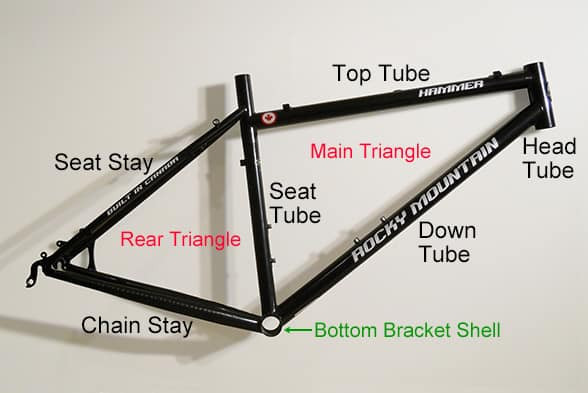 Bike Frame Diagram
Bike Frame Diagram
Top Tube
Often referred to as the “cross-bar,” the top tube is the horizontal or slightly angled tube that you typically straddle when mounting a traditional bicycle. While traditionally parallel to the ground, variations exist. Some bikes, particularly those designed for easier mounting and dismounting, feature significantly sloping or absent top tubes.
Head Tube
Located at the front of the frame, the head tube is a short, reinforced tube that serves as the crucial junction connecting the handlebars and the front wheel fork. It houses the “headset,” a bearing assembly that enables smooth steering by allowing the fork and handlebars to rotate freely.
Down Tube
The down tube is the robust, often thickest tube that extends from the head tube, just below the handlebars, down towards the pedal area (bottom bracket). It’s a primary structural member and often serves as a mounting point for water bottle cages and displays the bicycle brand’s logo.
Seat Tube
The seat tube runs vertically from the saddle downwards towards the pedals. The “seat post,” which supports the saddle, is inserted into the top of the seat tube. Adjusting saddle height is achieved by changing the depth of the seat post within the seat tube.
Seat Stays
Seat stays are two slender tubes that extend from the upper part of the seat tube, near the saddle, down to the rear wheel hub. Each seat stay terminates at a “rear dropout,” which interfaces with the rear wheel axle, securing the wheel to the frame.
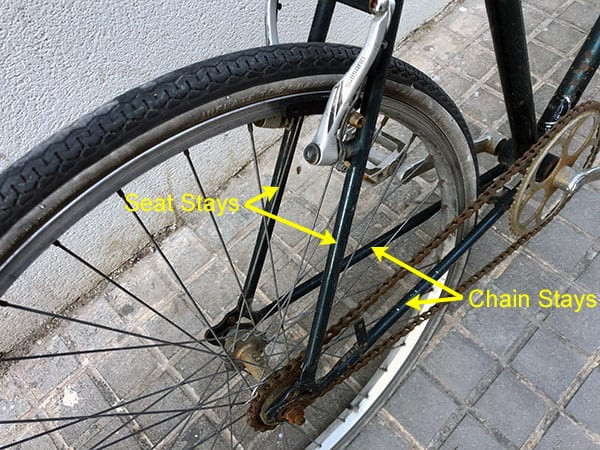 Seat and Chain Stays
Seat and Chain Stays
Chain Stays
Chain stays are two parallel tubes that run horizontally from the bottom bracket area (near the pedals) to the rear wheel hub. Positioned alongside the bike chain, these tubes get their name from their proximity to this essential drivetrain component.
Front of the Bike Parts
This section covers the components situated at the front of the bicycle, contributing to steering, control, and braking.
Fork
The fork is the component that directly connects the front wheel to the bike frame, enabling steering and absorbing road vibrations. It consists of “fork blades” that extend downwards on either side of the wheel and a “steerer tube” at the top, concealed within the head tube and connected to the headset.
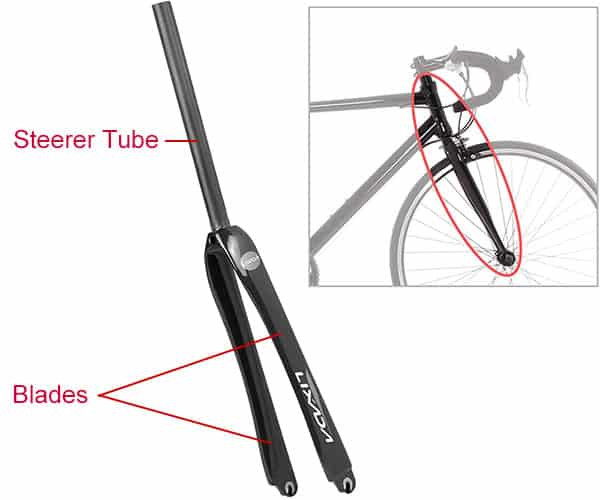 Bike Fork Diagram
Bike Fork Diagram
Headset
The headset is a critical assembly of bearings and races nestled within the head tube. It facilitates smooth rotation between the frame and the fork’s steerer tube. This allows handlebar input to translate into precise front wheel steering.
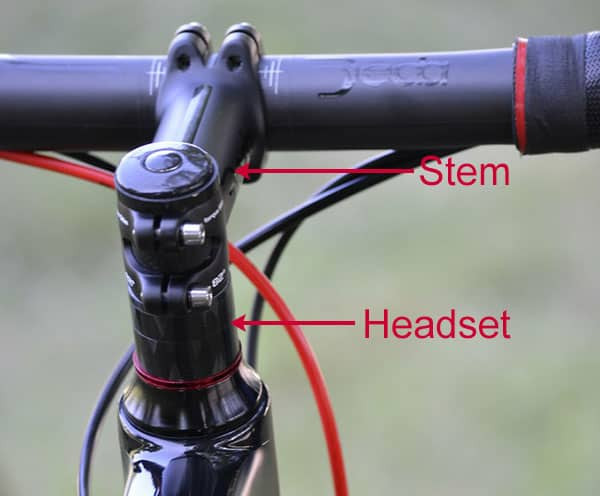 Bike Headset and Stem
Bike Headset and Stem
Stem
The stem is the component that bridges the gap between the fork’s steerer tube and the handlebars. Extending forward from the top of the head tube, the stem clamps onto both the steerer tube and the handlebars, providing a secure and adjustable connection.
Handlebars
Handlebars are your primary interface for steering and controlling the bicycle. Connected to the frame via the stem, handlebars come in various shapes and sizes to suit different riding styles. Flat handlebars are common on mountain bikes, hybrid bikes, and urban bikes, offering upright riding positions and responsive steering. Drop handlebars, characteristic of road bikes, provide multiple hand positions for varied terrain and aerodynamic efficiency. Many other handlebar styles cater to specific needs and preferences.
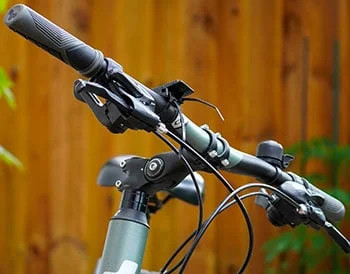 Straight handlebars
Straight handlebars
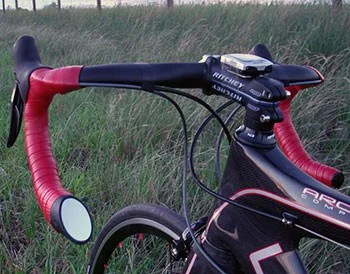 Drop handlebars
Drop handlebars
Brake Levers
Brake levers are handlebar-mounted controls that, when squeezed, activate the brakes to decelerate or stop the bicycle. In some integrated systems, brake levers are combined with gear shifters, forming “brake/shift levers” or “brifters.” Brake cables run from the levers down to the brake calipers at the wheels, transmitting the braking force.
Brakes (Rim vs Disc)
Bicycle braking systems predominantly fall into two categories: rim brakes and disc brakes. Rim brakes, applying friction directly to the wheel rim, are widespread due to their lightweight, cost-effectiveness, ease of maintenance, and adequate stopping power in dry conditions. However, their performance can be compromised in wet weather as water on the rim reduces friction.
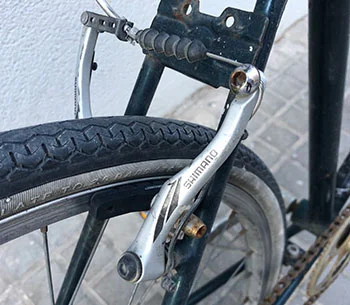 Rim Brakes
Rim Brakes
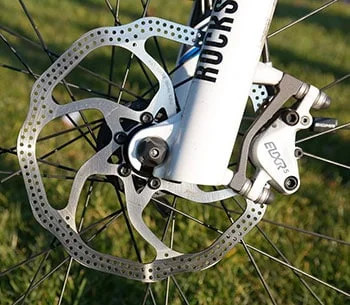 Disc Brakes
Disc Brakes
Disc brakes, on the other hand, utilize a metal rotor attached to the wheel hub. The brake caliper squeezes pads against this rotor to generate braking force. Disc brakes offer superior performance in wet conditions, greater modulation, and increased robustness compared to rim brakes. While historically prevalent on mountain bikes, disc brakes are increasingly adopted across all bicycle types due to their performance advantages.
Bike Wheel Parts
Wheels are fundamental to a bicycle, enabling motion and providing contact with the riding surface. A standard bicycle has two wheels (a “wheelset”), while tricycles utilize three. Each wheel comprises several interconnected parts.
Hub
The hub is the central component of the wheel, situated at its axis of rotation. It’s an assembly of three main parts: the hub shell, bearings, and axle.
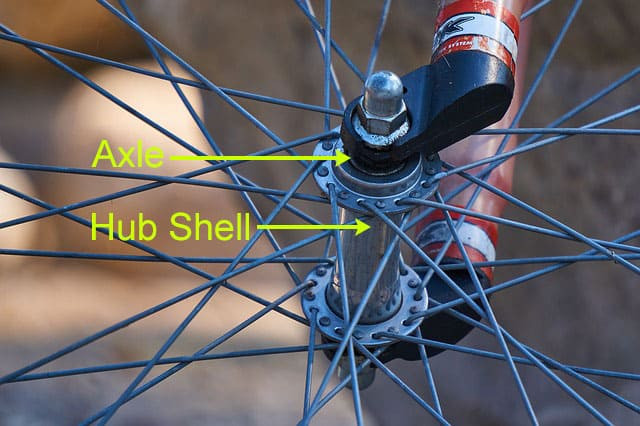 Wheel Hub Diagram
Wheel Hub Diagram
The “hub shell” is the outer casing to which the spokes are attached. The “axle” is a rod that passes through the hub and protrudes on either side, connecting to the fork or frame dropouts. “Bearings” are located between the axle and the hub shell, allowing the shell to rotate smoothly around the stationary axle.
Rim
The rim is the circular outer hoop of the wheel that holds the tire. Historically made of steel, modern rims are predominantly constructed from aluminum alloy for its lighter weight and strength. Rims designed for rim brakes feature a smooth braking surface on their sides for brake pad engagement.
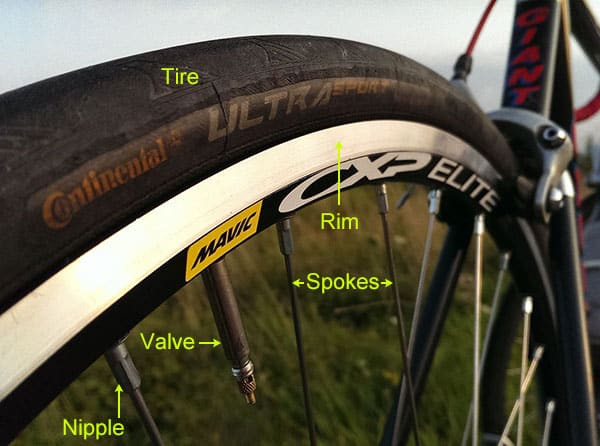 Bike Wheel Diagram
Bike Wheel Diagram
Spokes
Spokes are thin rods or wires that connect the rim to the hub, radiating outwards from the hub shell to the rim. They distribute tension evenly across the wheel, creating a strong, lightweight, and stable structure capable of supporting rider weight and pedaling forces. “Nipples,” small nuts at the rim end of the spokes, allow for spoke tension adjustment, crucial for wheel trueness.
Tire
The tire is the rubber outer covering mounted onto the wheel rim, providing traction, cushioning, and the primary contact point with the road surface. Tires are constructed from layers of rubber-impregnated fabric with a thicker outer rubber tread layer for durability and grip. Most bicycle tires are pneumatic, containing an air-filled “inner tube” that provides suspension and ride comfort.
Valve (Schrader vs Presta)
A valve, protruding through a hole in the rim, allows for inflation and deflation of the inner tube. Two common valve types are Schrader and Presta. Schrader valves are also used in car and motorcycle tires, known for their robustness and wider compatibility with inflation devices. Presta valves, narrower and often longer, are primarily used on bicycles, particularly road bikes, and are favored for their ability to hold higher pressures and their integrated valve core tightening mechanism.
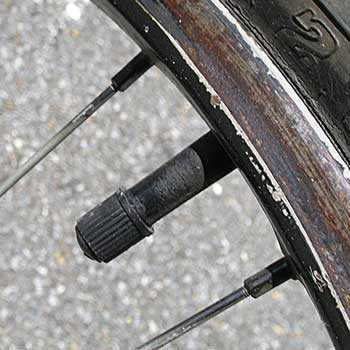 Schrader tire valve
Schrader tire valve
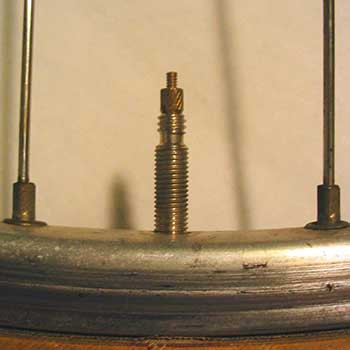 Presta tire valve
Presta tire valve
Back of the Bike Parts
This section details the components at the rear of the bike, primarily involved in propulsion and gear shifting.
Crankset / Chainset
The crankset, also known as the chainset, is the assembly that your legs power to propel the bike. It consists of chainrings (gears at the front) and crank arms to which the pedals are attached.
“Chainrings” are the front gears. Single-speed bikes have a single chainring, while geared bikes can have up to three, providing a range of gear ratios.
The crankset is connected to the frame via the bottom bracket, to the rear wheel via the chain, and to the rider through the pedals.
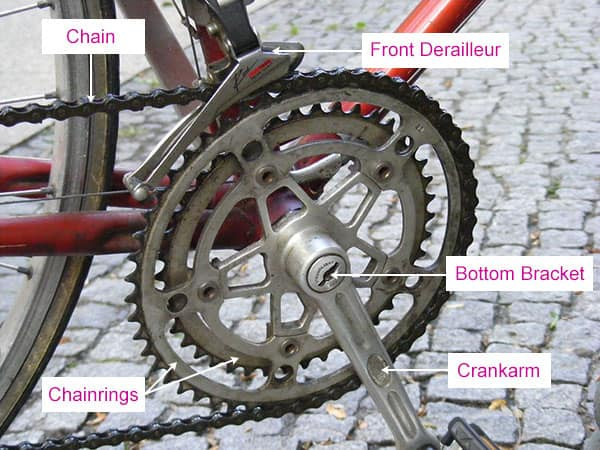 Crankset Diagram
Crankset Diagram
Pedals
Pedals are the rotating interfaces between your feet and the bicycle. Pushing down on the pedals transfers your leg power to the crankset and ultimately, the rear wheel, propelling you forward.
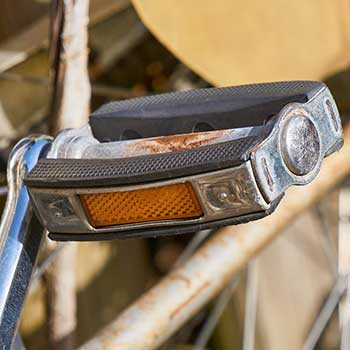 Flat pedal
Flat pedal
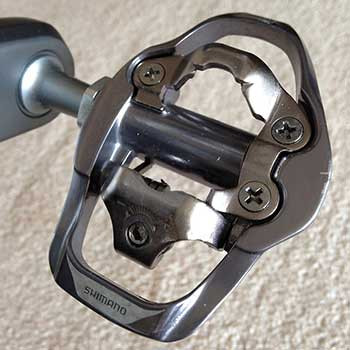 Clip-in pedal
Clip-in pedal
Broadly, pedals are categorized as flat/platform pedals, offering a simple platform to rest your feet, and clip-in pedals (also known as clipless pedals), which require special cycling shoes with cleats that engage into the pedal mechanism for a more secure and efficient connection.
Bottom Bracket
The bottom bracket is the bearing assembly that allows the crank arms to rotate smoothly. It comprises a spindle (to which the crankset attaches) and bearings, facilitating low-friction rotation. The bottom bracket is housed within the bottom bracket shell, a reinforced part of the bike frame at the base of the seat tube and down tube junction.
Chain
The bike chain is the crucial component that transmits power from the crankset to the rear wheel cassette. It loops around the chainrings at the front, runs along the chain stay, and engages with the sprockets of the cassette at the rear wheel hub.
Front Derailleur
The front derailleur is a mechanism that shifts the chain between different chainrings on the crankset, enabling front gear changes. It is only present on bikes with multiple front gears (more than one chainring).
Cassette / Cogset
The cassette, or cogset, is a cluster of sprockets (cogs) of varying sizes mounted on the rear wheel hub. These cogs constitute the rear gears of the bicycle. Single-speed bikes have only one cog, while geared bikes have a cassette with multiple cogs to provide a range of gear ratios.
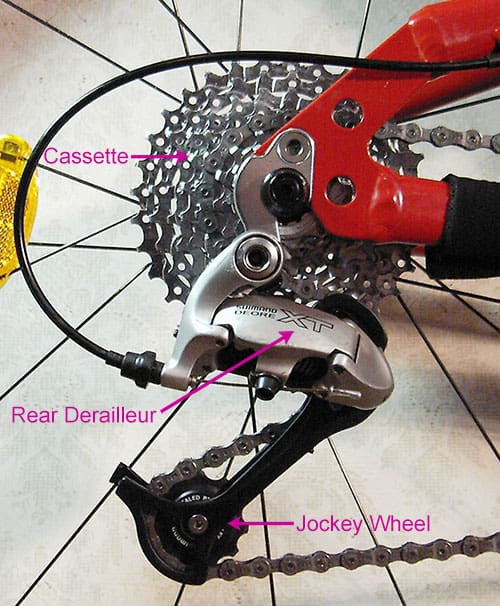 Bike Gear Diagram
Bike Gear Diagram
Rear Derailleur
The rear derailleur is the component responsible for moving the chain across the different cogs of the rear cassette when shifting gears. It works in conjunction with the jockey wheel to maintain chain tension. Rear derailleurs are essential for bikes with gears.
Jockey Wheel
The jockey wheel, also known as a derailleur pulley wheel, is part of the rear derailleur. It plays a vital role in maintaining chain tension and guiding the chain smoothly as it moves between different rear cogs during gear changes. Bikes without gears typically do not have a jockey wheel, unless it’s used as a chain tensioner in single-speed setups.
Bike Seat Parts
The seat area provides rider support and adjustability for comfort and pedaling efficiency.
Saddle
The saddle, also known as the seat, is the component the rider sits on. Saddles come in a vast array of shapes, sizes, and padding levels to suit different body types, riding styles, and preferences. All saddles have “saddle rails” underneath, which are used to attach the saddle to the seat post via a “saddle clamp.”
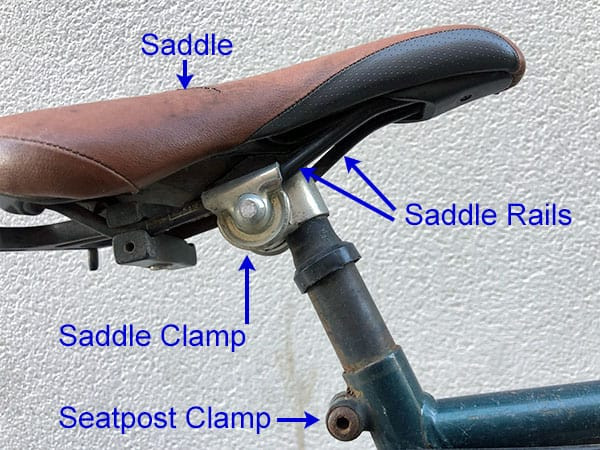 Bike Seat Parts
Bike Seat Parts
Seat Post
The seat post is a tube that inserts into the seat tube of the frame and supports the saddle. Its height can be adjusted up or down within the seat tube to achieve the optimal saddle height for the rider. A “seat post clamp,” located at the top of the seat tube, tightens around the seat tube to secure the seat post at the desired height.
More Good Stuff:
Best Bike Stand (and which ones to avoid)
 Win a Free Bike!
Win a Free Bike!
Win a Free Bike!
Bike Seat and Wheel Locks
